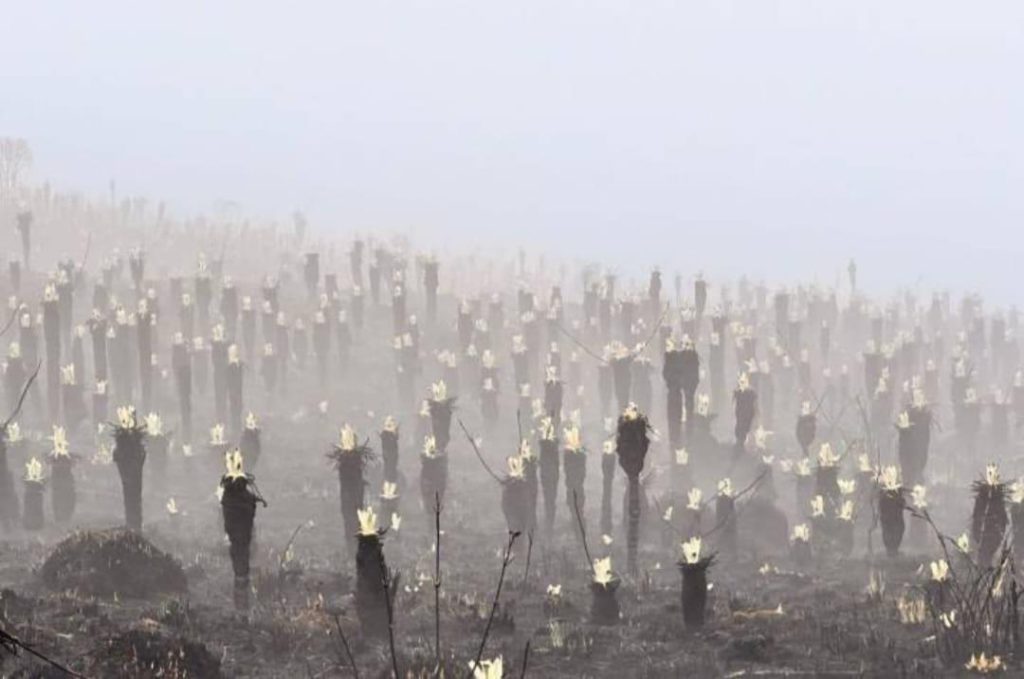
The frailejones burned in January’s raging fires in the Berlin paramo, in the department of Santander, are recovering. Exactly one month ago, on January 23, they were burned during the forest fire crisis in Colombia, due to severe drought and the effects of the El Niño phenomenon.
Today, images were released showing that these extraordinary plants are still alive and seem to be recovering from the devastating effects of the fire. Frailejones are plants native to the paramos of Colombia and Ecuador. They play a fundamental role in helping to regulate water flow and maintain humidity in the region by capturing moisture from the air and releasing it into the soil.
The images of a month ago, showing the thick trunks of the frailejones burned, made it seem as if these unique and distinctive specimens of this part of the country had been destroyed for good. The annual growth of this type of plant does not exceed one centimeter, so its recovery in a proposed repopulation pointed towards the need for decades to recover its former condition. However, a few hours ago the manager of the company Acueducto Metropolitano de Bucaramanga, Alejandro Estrada, confirmed that “nature responds with resilience”.
“Risen” from the ashes
The Berlin paramo is a beautiful place in the department of Santander, located in the eastern part of Colombia. The paramo is responsible for providing water to more than 30 municipalities in the region. There were four days of tireless firefighting. The image after the fire indicated the worst: almost 400 hectares were charred and incalculable damage was done to the frailejones.
“One month after facing the forest fire, we are happy to see how nature responds with resilience. The frailejones stand firm, showing their strength and resistance. Every effort counts in this stage of recovery and protection of our ecosystem,” said manager Estrada.
Experts from the Industrial University of Santander (UIS) had visited the affected area and at that time gave a glimmer of hope that the frailejones could survive this voracious fire. “When opening the leaves of the frailejones it was observed that the bud that allows its growth remained moist and protected by the same leaves, as well as its stem,” commented UIS professors Diego Suescun and Javier Pinzon.
“It is gratifying to observe that the hypothesis we initially had is becoming evident with the growth of the plants. In this case the frailejones, which was the plant community that most worried the human communities and the region, are alive,” said Professor Suescun.
The fire was not arson
The indignation was at its peak a month ago among the inhabitants of the region, when some images were released showing a person intentionally starting a fire. Later it was confirmed that the video did not correspond to that area, but was taken on the road that connects Bucaramanga and Giron, more than 50 kilometers from the paramo. At that time, the hypothesis that the fire started due to some electrical cables and a spark, which the strong wind of those days would have spread rapidly, was established.
Shortly after the flames were completely smothered, environmental experts suggested that the frailejones might not have died in the fire. The UIS researchers explained that these plants have a kind of leaf armor that protects their most vital and sensitive areas. Fortunately, this armor effectively protected them from the high temperatures they suffered during the fire.
“Now this is an area in intensive care that requires recovery and we specialists are the ones who are trying to identify, effectively, what this patient requires so that he can recover in the medium or long term. We are seeing that they are responding very positively with the weather conditions that have occurred in recent days,” said the Vice Rector for Research and Extension of the UIS, Fernando Rondon.
See all the latest news from Colombia and the world at ColombiaOne.com. Contact our newsroom to report an update or send your story, photos and videos. Follow Colombia One on Google News, Facebook, Instagram, and subscribe here to our newsletter.

